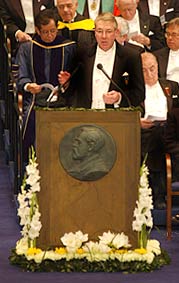Award ceremony speech
Presentation Speech by Professor Anders Zetterberg of the Nobel Committee at Karolinska Institutet, December 10, 2001.
Translation of the Swedish text.

Copyright © Nobel Media AB 2001
Photo: Hans Mehlin
Your Majesties, Your Royal Highnesses, Honoured Nobel Laureates, Ladies and Gentlemen,
Cell division is a fundamental process of life. All living organism on earth are descended from an ancestral cell that appeared about 3 billion years ago, and which has undergone an unbroken series of cell divisions since then. Each human being also began life as one single cell – a cell that divided repeatedly to give rise to all one hundred thousand billion cells that we consist of. Every second millions of cells divide in our body.
The cycle of events that a cell completes from one division to the next is called the cell cycle. During the cell cycle the cell grows in size, it duplicates its hereditary material – that is, it copies the DNA molecules in the chromosomes – and it divides into two daughter cells.
This year’s Nobel Laureates have discovered the key regulators of the cell cycle, cyclin dependent kinase (CDK) and cyclin. Together these two components form an enzyme, in which CDK is comparable to a “molecular engine” that drives the cell through the cell cycle by altering the structure and function of other proteins in the cell. Cyclin is the main switch that turns the “CDK engine” on and off. This cell cycle engine operates in the same way in such widely disparate organisms as yeast cells, plants, animals and humans.
How were the key regulators CDK and cyclin discovered?
Lee Hartwell realized the great potential of genetic methods for cell cycle studies. He chose baker’s yeast as a model organism. In the microscope he could identify genetically altered cells – mutated cells – that stopped in the cell cycle when they were cultured at an elevated temperature. Using this method Hartwell discovered, in the early 1970s, dozens of genes specific to the cell division cycle, which he named CDC genes. One of these genes, CDC28, controls the initiation of each cell cycle, the “start” function. Hartwell also formulated the concept of “checkpoints,” which ensure that cell cycle events occur in the correct order. Checkpoints are comparable to the program in a washing machine that checks if one step has been properly completed before the next can start. Checkpoint defects are considered to be one of the reasons behind the transformation of normal cells into cancer cells.
Paul Nurse also used the genetic approach in his cell cycle studies, but in a different kind of yeast. In the late 1970s and early 1980s he discovered the gene cdc2, which could be mutated in two different ways. Either the cells did not divide, or they divided too early. From this he correctly concluded that cdc2 controls cell division. He later discovered that cdc2 not only controls cell division, the final event of the cell cycle, but has a key regulatory function for the whole cell cycle, including that described for CDC28 in baker’s yeast. This key function was shown to be that of CDK in the cell cycle engine. By moving human genes into yeast cells, in 1987 Nurse isolated a human cdc2 gene. This human cdc2 gene functioned perfectly in yeast cells. Thus, the CDK function in the cell cycle engine had been concerved through more than one billion years of evolution – from yeast to man.
Tim Hunt discoverd the other key component of the cell cycle engine, the protein cyclin, which regulates the function of the CDK molecule. Working with sea urchin eggs as a model organism, in 1982 he discovered a specific protein that increased in amount before cell division but disappeared abruptly when the cells divided. Because of these cyclical variations, he named the protein cyclin. These experiments not only led to the discovery of cyclin, but also demonstrated the existence of periodic protein degradation in the cell cycle – a fundamental control mechanism. Hunt also showed the existence of cyclins in other, unrelated species. Thus cyclins, like CDK, had been conserved during evolution.
It is now almost fifty years since the structure of the DNA molecule – the double helix – was discovered, leading to a molecular explanation of how a gene can make a copy of itself. With the discoveries of CDK and cyclin we are now beginning to understand, at the molecular level, how the cell can make a copy of itself.
Dr. Hartwell, Dr. Hunt and Dr. Nurse.
Your fundamental discoveries have profoundly increased our understanding of how the cell cycle is controlled. This new knowledge has a huge impact on cell biology with broad applications in many fields of biology and medicine.
On behalf of The Nobel Assembly at Karolinska Institutet I wish to convey our warmest congratulations, and I now ask you to step forward to receive the Nobel Prize from the hands of His Majesty the King.
Nobel Prizes and laureates
Six prizes were awarded for achievements that have conferred the greatest benefit to humankind. The 14 laureates' work and discoveries range from quantum tunnelling to promoting democratic rights.
See them all presented here.
